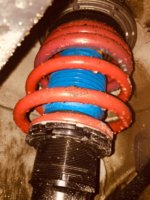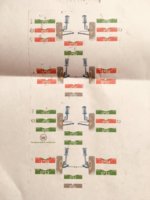Finally had the SoLows fitted and the wheels. Wow what a difference!
View attachment 49913
View attachment 49914
View attachment 49915
looks good
Finally had the SoLows fitted and the wheels. Wow what a difference!
View attachment 49913
View attachment 49914
View attachment 49915



I can tomorrow for you if that is ok?@T6180
I'm considering buying So low coilovers and looking at your T6,
can you say what distance you have from the center of the wheel to the arc ?
Thanks
I can tomorrow for you if that is ok?
I prefer them than b14s and they still have easily 20-25mm adjustment, I do have the the machined top-mounts fitted though.
Yes, tomorrow will be great, thank you.
Currently I have B14's in the lowest setting + machine top mounts, the effect is weak, it's still 15-20mm too high and a bit harsh at 255/35 r20
The converters generally do offer sport springs as a cheap and cheerful way to get the van looking good . sadly springs alone dont get great results in the handling and comfort area . The other problem is if they spec the spring wrong the back end will sag approx 20 to 25 mm sending the vehicle rake angle out and this can give other issues . I wouldn't worry about the warranty too much particularly in light of the massive amount of mods the converter will do that could invalidate warranties rather buy a good quality suspension kit spec' d correctly and these parts will come with a warranty as good as the VW one and there wont be a conflict . You will then have a great looking perfect handling vehicle PM me for proper recommendationsThanks for taking the time to give such a comprehensive view. I'm just embarking on my mod journey and find these invaluable in guiding me through a potential minefield. I like the lowered look but am certainly not proposing anything as radical as SoLow's 130mm, and want to retain a comfortable ride balanced with looks/handling. My converter is proposing a 30mm drop using genuine VW Sportline springs coupled with 20 inch rims on my new T30 LWB Highline, but I'm not sure if this is going to achieve the look and feel I'm after. As it's a new vehicle, I'm reluctant to do anything that might invalidate the manufacturer's warranty, but I wonder if I should be considering/discussing alternatives with them before the start the conversion (when lock down eventually ends!). Thanks
Thanks for expanding on the critical points . I do sometimes wonder why UK isn't more pro active clamping down on excessive car modifications. like most of Europe is ,I started designing suspension when I left uni and worked for Eibach and Bilstein before moving onto motorsport applications of WRC and F1, (and now Rolls-Royce but that’s electric controlled)
I don't normally post on any forum about suspension because it can be subjective and people only recommend what they have just brought. CRS's feedback is worth listening too, even though I like a low car.
The most important thing about suspension is the travel, not the brand, how low it is or ride height. Travel is everything and if this isn't right, no amount of damping will fix it.
When you change the springs and lower a car/van, you're reducing the amount of bump travel. The spring rate needs to be increased so the closing load on the spring when the damper is closed needs to be the same as series (was a TUV regulation). So if you really lower a car/van, you can drive round with very little bump travel which means it doesn't roll much, but can be harsh. To get around this, SO-LOW have shorten the damper body so at the static ride height, you have a good amount of travel in bump and rebound which sound great.
The reason OEM don't have a short damper body is because on full bump conditions the wheel can touch the body/arch liner and this isn't allowed by TUV. I don't know if the SO_LOW kit is too short and allows the wheel to go too high in the arch or not.
The TUV is there to approve the system and ensure its save and suitable for use. It takes away the need for Joe Public to be a suspension expert and therefore it's a requirement on any modified car in Germany to have this approval. In the UK we can do anything we like and create death traps without knowing it.
If you really lower the car/van too much, bump steer is a concern. Although you can get the geometry correct at the static ride height, as soon as you hit a bump or the car rolls, the tracking will change. This is normal and we plan this into the suspension design with zero bump steer around the normal ride height. In compression the wheel turns in and extension it turns out. This makes the vehicle directionally stable. When you lower the van too much, you move away from neutral bump steer. The further away you are the more the bump steer has an effect so lowering too much causes stability concerns. Lowering a car/van 30-50mm will have little effect on bump steer.
Sum up - Going to low is dangerous. Only buy an approved TUV suspension kit. I always advise buying a damper/spring kit rather than from 2 separate manufacturers.
Lets not get started on progresive / digressive damping rates, rebound spring.........
I started designing suspension when I left uni and worked for Eibach and Bilstein before moving onto motorsport applications of WRC and F1, (and now Rolls-Royce but that’s electric controlled)
I don't normally post on any forum about suspension because it can be subjective and people only recommend what they have just brought. CRS's feedback is worth listening too, even though I like a low car.
The most important thing about suspension is the travel, not the brand, how low it is or ride height. Travel is everything and if this isn't right, no amount of damping will fix it.
When you change the springs and lower a car/van, you're reducing the amount of bump travel. The spring rate needs to be increased so the closing load on the spring when the damper is closed needs to be the same as series (was a TUV regulation). So if you really lower a car/van, you can drive round with very little bump travel which means it doesn't roll much, but can be harsh. To get around this, SO-LOW have shorten the damper body so at the static ride height, you have a good amount of travel in bump and rebound which sound great.
The reason OEM don't have a short damper body is because on full bump conditions the wheel can touch the body/arch liner and this isn't allowed by TUV. I don't know if the SO_LOW kit is too short and allows the wheel to go too high in the arch or not.
The TUV is there to approve the system and ensure its save and suitable for use. It takes away the need for Joe Public to be a suspension expert and therefore it's a requirement on any modified car in Germany to have this approval. In the UK we can do anything we like and create death traps without knowing it.
If you really lower the car/van too much, bump steer is a concern. Although you can get the geometry correct at the static ride height, as soon as you hit a bump or the car rolls, the tracking will change. This is normal and we plan this into the suspension design with zero bump steer around the normal ride height. In compression the wheel turns in and extension it turns out. This makes the vehicle directionally stable. When you lower the van too much, you move away from neutral bump steer. The further away you are the more the bump steer has an effect so lowering too much causes stability concerns. Lowering a car/van 30-50mm will have little effect on bump steer.
Sum up - Going to low is dangerous. Only buy an approved TUV suspension kit. I always advise buying a damper/spring kit rather than from 2 separate manufacturers.
Lets not get started on progresive / digressive damping rates, rebound spring.........
Andy the problem is the practice of dropping vans too far has become so common place that we all think its normal and assume buyers think its safe . Most countries in Europe will simply take the car off the road if the mods done aren't covered by TUV and with in spec .Hi @Littleblackflash
Interesting reads between you and Steve at CRS
So basically if not buying a TUV kit or don’t know what your doing don't bother
Sounds like there’s a lot of poor kits out there
Thanks for the info
Please feel free to share your wealth of wisdom between you both
Andy
Andy the problem is the practice of dropping vans too far has become so common place that we all think its normal and assume buyers think its safe . Most countries in Europe will simply take the car off the road if the mods done aren't covered by TUV and with in spec .
No there isn't any thing on MOT that would be an issue unless the excessive drop had torn a control arm bush or something like that .Makes sense,
I take it there’s no requirement on the MOT to check the said items for a TUV
Andy
Kwik fit have issued a directive not to attempt any alignment on lowered vans . ( in our area not sure if its national thing )@T6180 how you finding the front tyre wear? When I have my extremes wound down the camber changes enough to scrub the inside edges out... I can’t get the 4 wheel alignment done either because there’s not enough arch gap to fit the gauges on.
